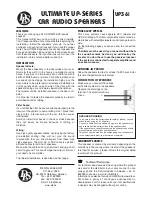
13
grapefruit into the vent and push the ball upwards, into the woofer cavity. Do this in both speakers,
and if one handful is not sufficient to reduce the overall bass level, continue to place Dacron balls
upwards into the woofer cavity.
B). If the frequency range between 20-30Hz sounds too powerful in your particular room, simply
place a large handful of the Dacron in each vent tube; this will lower the efficiency of the vent tuning.
If the bass is still too loud, place another handful in each vent.
If the low frequency range has come into proper balance, stop there. If you change locations, you can
always remove the balls of Dacron by reaching into the vent.
BASS RESPONSE TUNING FOR TUBE AMPLIFIERS:
Since tube amplifiers have “air and liquidity” in the mid and treble ranges, many audiophiles use
them. However, the saturation, back EMF, and transient response delays caused by the output
transformers may cause sluggish bass response which can be heard when using any speaker that has
response below 30Hz. The deep bass can be tightened considerably by the addition of several handfuls
of Dacron in each vent which is then pushed into the enclosure. It is possible to tighten the VR-4SR
Mk2's bass response to a degree not heard with other speaker systems, so don’t be afraid to
experiment!
Try using solid core wire on the woofer modules when using tube amplifiers if you are trying to
tighten up the bass, since stranded wire will emphasize the bass fullness you are trying to equalize.
However, using silver cables will also tighten the bass.
The best possible bass response is obtained from high current solid state amplifiers, making bi-
amping the ideal choice for the critical audiophile who wishes to have the best sound in every part of
the frequency range. See the section above regarding bi-amping.
LACK OF APPARENT BASS:
In some rooms, especially those with “soft” walls such as wallboard over studs, open floor plans, and
rooms with poor dimensional ratios, it is possible to “lose” bass response. Also, when sitting in a
“null,” it is possible to perceive, incorrectly, that there is a lack of bass power in the speaker system
itself. In these cases, it will be necessary to move either the speaker position or the listening position
in order to optimize the response. By playing a recording with a repeating bass line, try walking
around the room until you find the places where there is apparent bass. It will be necessary, in some
cases, to reposition the speakers in order to allow the room to boost the bass by using the natural
“gain” of the boundary reflections. Simply move the speakers closer to the rear wall or side wall in
small increments until the bass sounds right.
ANCILLARY EQUIPMENT
The VR-4SR Mk2 is far more transparent than any other competing design, including electrostatics.
(If you don’t believe this, put any electrostatic next to the VR-4SR Mk2 and use a transparent
switching device such as a copper knife switch to directly compare the sound of the VR to the
electrostatic. Make sure that you use the same channel, since the electronics may have a large
difference in sound between the channels, and the same brand of cable. It may be necessary to use a

































